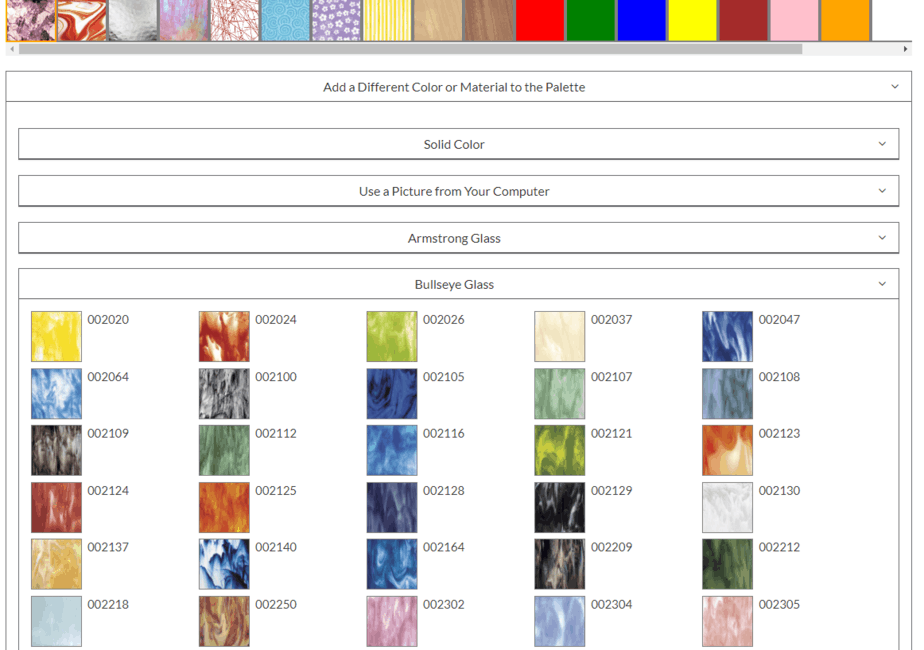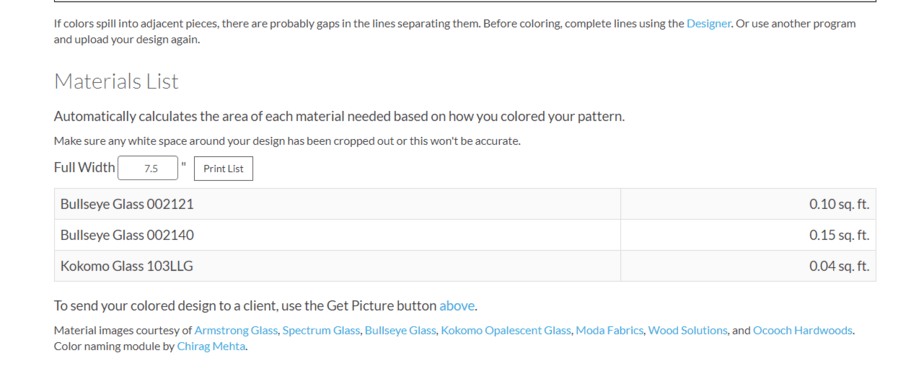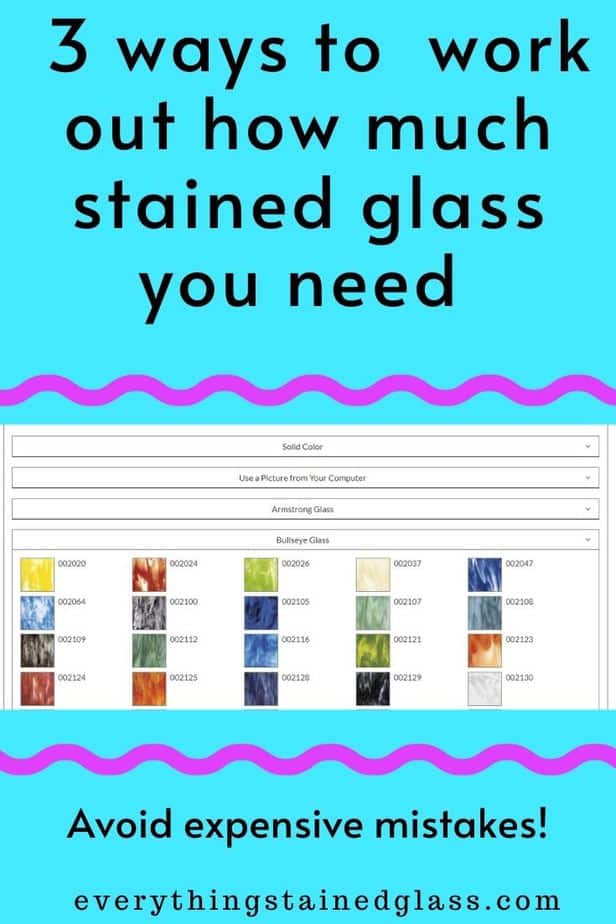
How do you work out how much stained glass you need for your next project? This page will help you calculate how much glass to buy before you get started on your stained glass piece. It’s important that you don’t run out half way through and end up having to use glass that doesn’t quite match. Yikes!
Calculate How Much Stained Glass You Need – Method 1
The method below might help you:
- Colour your design/pattern with your proposed glass choices first. This will help you visualise what percentage of each colour you need.
- Multiply the height by width to get the total area. You can do this in inches to get square inches if you find it easier than feet.
- Add between 15 – 25% for wastage (this varies, depending on whether the pattern has mostly straight lines, whether there’s lots of difficult cuts, whether the glass you’re using is easy or difficult to cut)
You might want to increase this to 30% to be totally sure you won’t run out if your cutting is a bit ‘rusty’!
You now have a new total – the area + 30%
- Now work out by eye the % of each of the colours. E.g.: red = 25%, blue = 25%, clear = 50%. They need to total 100%
- Then work out the area needed for each colour:
- Let’s take the easy one (clear = 50%). Divide your total (the area + 30%) by 2 to get 50%. That’s the amount of clear you need – in square inches!
- To get it into square feet, divide it by 144. That gives you the area of clear you need.
This isn’t as complicated as it sounds if you do it step by step. It will at the very least give you a ball park figure to start from.
Work Out How Much Stained Glass You Need – Method 2
If you want to save time and be really accurate then using stained glass design software is the solution. These programmes do WAY more than just calculate glass usage but this is a very useful feature for working out costs.
My favourite is Rapid Resizer. It’s web based which is better as there’s nothing to download and it’s kept bang up to date. It has a lot of very useful features and, particularly close to my heart, it works on a Mac which I use.
Inside Rapid Resizer (affiliate)* you can create a pattern from a blank slate or upload an existing image. You then set the size of the pattern and add glass choices from a database of glass available inside the programme. It then calculates the amount of glass you need and automatically re-calculates if you change the dimensions of the piece. Like magic!
Once you have the glass requirement you can price it up using your local store price list. It also lets you print the glass estimate so you can take it to the shop easily.
This image gives you an idea of the glass selection function:

As an aside, Rapid Resizer does some wizzy things! I especially like the way you can set a measurement for a portion of your image, say you want the centre of a mandala to be 5″ – it then resizes the rest of the pattern around that correctly. No more figuring out all the geometry.
Here’s a glimpse of how easy it is to see the glass calculations in the programme:

Why Rapid Resizer?
There are other options for glass pattern designing and pricing but I prefer Rapid Resizer * as it’s easy to use – and that’s saying something from me! It also has a raft of very valuable features. It works on a Mac, which is essential for me and it is very simple to resize and print patterns to any size.
If you’d like to find out more I’ve written a tutorial on all the things Rapid Resizer does on this page.
There is also a range of different levels so you can get on to meet your specific needs rather than a ‘one size fits all’. There’s even a free version so you can give it a try first. Crucial for me is that the support is first class. I’ve had a fair bit of contact with the owner and developer of the software and he’s always been very generous with his time and willing to answer questions which I find very reassuring.
* Affiliate Transparency: if you decide to get Rapid Resizer (affiliate) through one of my links I will earn a small commission from the company but feel free to find the product through a Google search if you’d prefer that.
Estimate How Much Stained Glass You Need – Formula 3
Another way you can estimate how much stained glass you need is favoured by those who find maths a bit difficult. It’s more of a visual calculation:
- Lay your stained glass pattern out on a work surface
- Cut some 12″ squares out of tracing paper. Cut one for each colour you’re using.
- Trace the pattern pieces on to the tracing paper according to colour. You may need more than one square for each colour if it’s a fair-sized pattern.
- This will give you a rough estimate of how much stained glass you need.
- Add an additional percentage to cover breakage and wastage.
It’s always safer to have ‘extra’ glass, rather then ‘just enough’.
Add your comments below sharing what method YOU use to calculate how much stained glass you need. Thanks in advance.

Learn about Pricing Stained Glass here
Find out about stained glass software to help you design and print full size patterns from home.

I follow your email tips very closely and find them so informative. However, am I right in assuming that you are aiming them mostly at the American market? I have just read your latest mail ‘Never Run Out Of Glass Again’ good advice but as a European based expert I wonder why you post measurements in inches?
Surely being European based you should be using metric measurements, All the glass I have seen for sale advertised here in the UK is sold in metric measurements, not Imperial.
Milly, the UK and Ireland swapped to metric years ago starting in 1980, most people especially anyone under 40 or so would only know metric measurements and possibly will be completely confused by inches.
I personally don’t think it is right that you should publish in inches just to pander to the one of the only countries in the world still using Imperial. Your followers I am sure come from all over the world and that is almost exclusively metric.
Only the USA, Liberia and Myanmar officially use Imperial measures
All my paid-for online classes include both metric and imperial measurements.
Although I don’t have to excuse myself for all my 100% free website tutorials and newsletters, I do want to clear this up.
80% of my readers are from North America and as a teacher I want to make it easy for them to learn.
I appreciate your thoughts but I do wonder why you’re using such emotive and opinionated words (‘pander’ ‘I… don’t think it is right’ ‘you should be’) for a website that gives free tutorials to those wanting to learn stained glass.
If you have trouble with the conversions, Google is your friend.
Milly , nothing to do with today’s email. Question, can scrap glass be used to make frits. And if not what do you do with scrap pieces? Thanks
With a kiln and thermal shocking, yes. Heat them up in a metal bowl, and dump them into a bucket of cold water. Always dramatic! Otherwise, here are some scrap glass ideas: https://everythingstainedglass.com/scrap-glass
I enjoyed reading today’s methods for estimating glass needs. It is always a bit of a gamble if you are trying to economize. Some time ago, however, I decided it might be a false economy, especially if I come up short or change the design a bit and have to pay another freight charge in addition to the cost of more glass. I now order more than I need, and never run short for the project at hand. The biggest benefit is building an inventory of glass on hand and often not having to buy a lot of glass for a project in the future.
Regarding the resizing software you mentioned, I have found the free Adobe software useful for resizing a drawing. You must scan your drawing and create a PDF version first, then you can print it any size you want using the Poster feature. If you compare the size of your original to the size you want you can come pretty close by increasing the size proportionally. It might take a couple tries if you must have a specific size, but not too many.
That’s a brilliant help regarding the Adobe software, thanks George.
I totally agree about false economy. And as you say, it does enable you to have more choice for that ‘exact right bit of glass’ when you’re working on various projects. Thanks for your thoughts and help.
Hi Milly thanks for all your emails and all your hints on glass I’ve learned so much from you…I’m am now looking into doing some Mosaics I hope I will have as much fun, I will try to keep you posted…Tony in Florida
Thanks Tony and good luck with your tangential journey. I’m not a mosaic expert but there are others ‘out there’ that can help you.
Hi Milly,
I’ve been doing stained glass, first copper, now lead, for the last few years on and off. My project of the moment is a pretty big lead window for my workshop. The tips for calculating glass needed is a keeper. I keep meaning to thank you for your very useful advice but always get too busy. One day I may even have time for your online courses. Thank you and best regards, Melanie in France
That’s kind of you to take the time Melanie in France 😉 thank you! My available classes right now are for beginners and refreshers so may be a bit basic for you… but I have a more advanced one in the pipeline for early next year so keep your eyes peeled.
I am fairly new to stained glass so when I receive information articles from Milly Frances I first read them. I then print them so I can go back and refresh my memory when I come upon the need. The articles are a great help to me and I use the information in most of the articles.
Thomas that is SO nice of you to say, what a lovely thing for me to find this morning, thank you 🙂
Anyone who wants to receive my free newsletters can sign up here. I look forward to sharing more tips with you all.